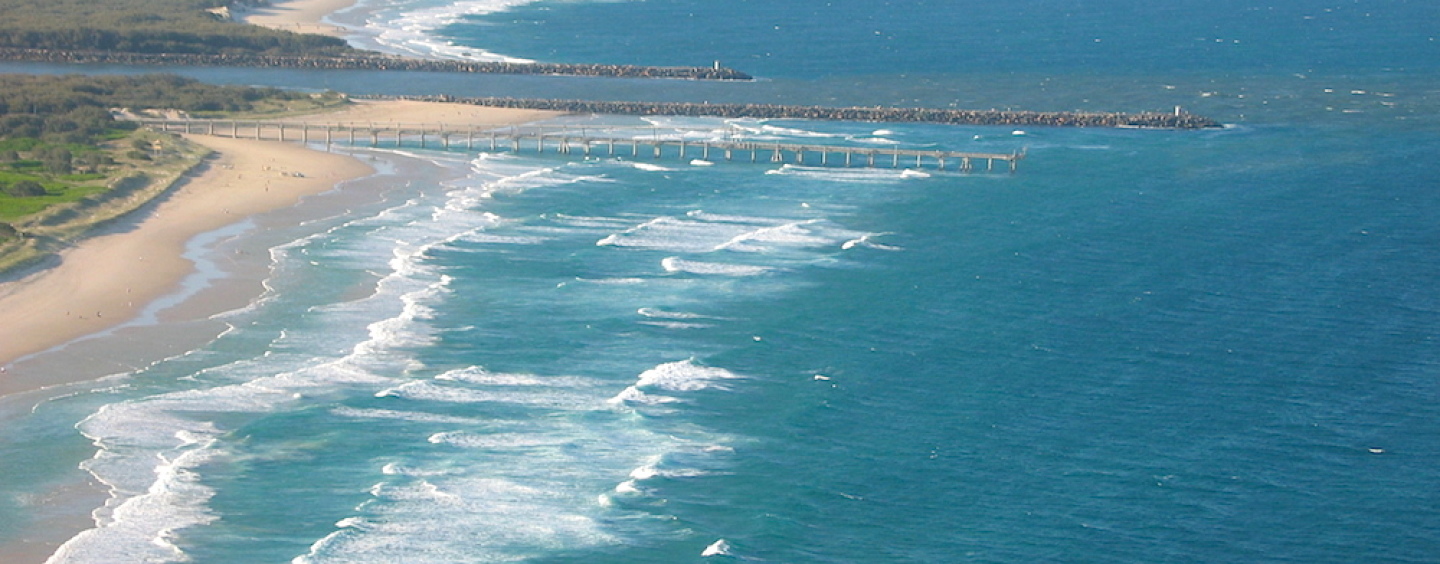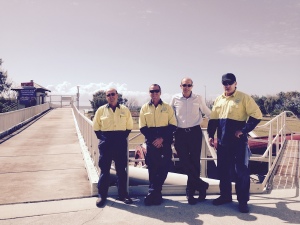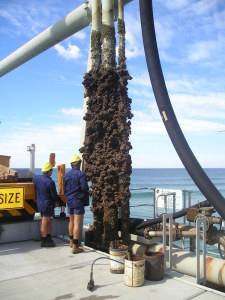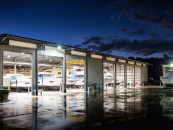The Gold Coast needed a Seaway, a permanent entrance for navigation that could withstand ocean swells. But with it came the challenge of addressing natural sand movement. Patrick Molnar writes about the world’s first Sand Bypass System, an engineering feat that has made The Spit, Wave Break Island and South Stradbroke beaches special spots on the Gold Coast.
The Spit is undoubtedly one of the most popular places on the Gold Coast which is also the location of the Gold Coast Seaway. Boaties love the Seaway, divers explore the underwater world below, fishers enjoy the challenge of catching fish, and surfers master the surf off South Stradbroke.
Gold Coast Seaway is the main navigation entrance from the Pacific Ocean to the Broadwater that can be found between South Stradbroke Island and The Spit. It was constructed in 1986 and it is a significant part of the most unique engineering feat in Australia—the world’s first Sand Bypass System.
Before the construction of the Gold Coast Seaway (or Southport Seaway), the Nerang River mouth to the Pacific Ocean was a highly unstable and dangerous entrance. Approximately 500,000 cubic metres of sand moved northward along the Southeast Queensland coast each year as a result of predominant south-easterly winds, wave climate and the significant northern drift of sand.
The Nerang River entrance to the Pacific Ocean steadily migrated up to 60 metres each year, causing land erosion and changing sandbanks. In the 1800s, the entrance was located where Jupiter’s Casino is now, and by 1930, it moved up to where Sea World stands today.
Because of this ongoing movement, South Stradbroke Island had continuously eroded. The entrance also changed in width and depth, resulting in extremely dangerous navigational conditions and numerous boating accidents.
Beach erosion problems on the Gold Coast was previously researched and reported to the Queensland Government by The Delft Hydraulics Laboratory of Holland. They again presented a report in 1976 which established a number of parameters for the final design of the scheme.
It was obvious that the most economic approach would be to form a new and secure entrance by constructing two training walls at The Spit. The design of these walls had to ensure they would be capable of withstanding the cyclonic conditions and would also reduce the entry of ocean swells.
However, construction of man-made structures such as the Seaway rock walls raised some questions regarding the natural flow of beach sand.
John Bendel was part of the supervision team for the construction of the Seaway project between 1983 and 1986. Following that, he has been employed by the Gold Coast Waterways Authority in 1989.
“Research showed that when constructing man-made structures such as the Seaway rock walls to provide a safe Seaway entrance, the rock wall that extends out into the ocean interrupts the natural flow of beach sand predominately moving from south to north, and therefore an artificial sand bypassing system is required to re-establish the natural flow of the sand,” says John.
The enormous project cost $50 million, used approximately one million tonnes of imported rock, two layers of 20-tonne concrete cubes armoured with rocks of sizes up to 15 tonnes (4,500 cubes in total), and dredged 4.5 million cubic metres of sand.
The Sand Bypass System uses high-pressure water and 10 jet pumps to transfer sand from the southern side of the South Wall, and discharge it onto the beach on South Stradbroke Island. It was designed to mimic the natural flow of sand along the coast line and avoid any impacts to the coastal environment. “Being the first of its kind, the jet pump technology was borrowed from mining settlement ponds.” adds John.
It consists of a steel-structured jetty, constructed 500 metres out to sea and 250 metres south of the southern training wall. Ten jet pumps, suspended from the jetty at 30-metre intervals from the seaward end, are submerged to 11 metres below sea level.
The Sand Bypass System is an integral part of the Seaway and it pumps 500 cubic metres across the Seaway per hour and runs up to five days per week on an as-needs basis, with the capacity to run unattended overnight and at peak capacity if required.
“The main functions of the Sand Bypass System are to remove the build-up of sand behind the south wall thereby preventing any excess sand from flowing around the south wall into the Seaway entrance and therefore maintaining safe navigational access. The sand bypassed to South Stradbroke Island re-establishes the natural sand flow which prevents erosion of the beach on the island,” explains John.
“Due to increasing electricity costs an energy efficiency review was recently carried out and some minor modifications will be made. However, due to the high level of maintenance provided by the operating staff over the past 30 years the system will be able to continue operating for many years to come.”
Russel Ratcliffe and Frank Hiron are two of the three plant operators who commenced work in January 1986, and have been working in their original position for 30 years. Jason Apps, a new operational team member, joined them four years ago.
Their assignment is to economically operate the Sand Bypass System and maintain the system to a high standard. It is undoubtedly a challenging role, considering that the system is the first of its kind in the world.
“Being tradespersons and coming from a mining background, we could see the challenges involved with pumping sand from a fixed jetty. As the system was a design-and-construct project and the first of its life to iron out bugs and cope with operating in the natural environment, the operations team changed, redesigned and upgraded many components to achieve a more efficient and economical Sand Bypass System,” explains Russel.
Their biggest challenge is to develop maintenance and operating procedures for the system and meeting the challenges of designing and fabricating components capable of withstanding the incredibly harsh and aggressive environment they need to operate in.
“To be able to overcome those challenges through the application of our engineering skills is personally very rewarding,” says Frank.
The system has proved to be extremely successful during its 30 years of operation and has transported more than 16 million cubic metres of sand.
“The construction of the Gold Coast Seaway and Sand Bypass System has provided a safe navigable access between the Broadwater and the Pacific Ocean. Also, the dredging of navigation channels in the Broadwater has enabled the boating fraternity, business and industry to safely move about the waterways. The enhanced navigational access has allowed for the massive expansion of the boating industry in the past 30 years. The Gold Coast is one of the largest recreational and white boat waterways in Australia,” declares John.
The older staff members have a unique understanding of the weather and its impact on the operation of the plant. This knowledge is handed on through daily education of younger staff members while on the job.
“Through the development and ongoing review of the system’s operating manual, work procedures and with the help of a programmed maintenance system that holds years of historical plant data, we are able to provide a library of information to the younger members of the staff,” explains Russel.
Being the world’s first system for sand bypassing, the original design of the system caught the attention of many countries around the globe. It has been replicated in Japan, South America and South Africa, and locally at the Tweed River in New South Wales. Ongoing research and development ensure the smooth operation of this innovative Australian engineering feat.





























